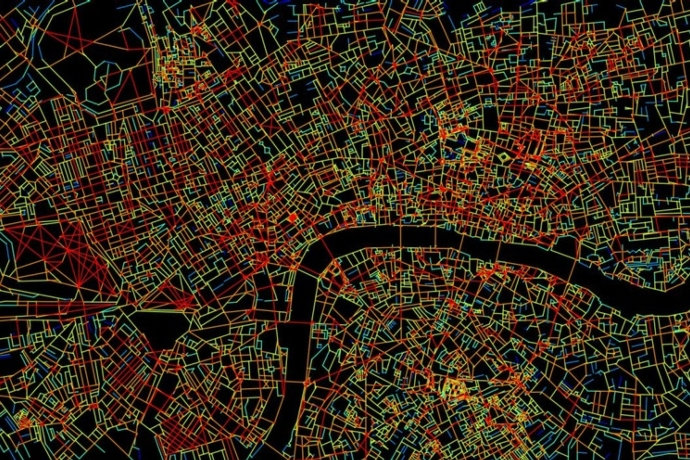Satellite navigation disables the brain areas responsible for building routes.

In the human brain there is a built-in "GPS-navigator", which is based on the memories of past travel experiences to create future routes. But how does this work when a person gets into a new environment? How to successfully manage existing knowledge? What happens in the brain when we come to a new city and use satellite navigation technology to get to our destination?
Scientists from University College London have studied these issues and concluded that when a person uses satellite navigation to get to a destination, it “turns off” parts of the brain that could be used to build routes on their own.
')
In a previous study, researchers conducted a tour of the streets of Soho in London for the participants in the experiment, and then used functional magnetic resonance imaging (fMRI) to scan their brains at the time when the subjects examined 10 videos with various simulated routes along these streets. Some volunteers had to decide at intersections what the shortest path would be to a given destination, while others received instructions on where to turn at each intersection.
Thus, a team of researchers studied activity in the hippocampus , a region of the brain that is involved in the process of memorization and navigation, as well as in the cerebral cortex, which is responsible for planning and making decisions. Apparently, during a self-searching for a route by a person, his hippocampus encodes two different environmental maps: in one, it tracks the distance to the destination point in a straight line using the frontal area of the hippocampus, in the other - the “right” route to the target, which is regulated by the back area.
During route compilation, the hippocampus acts as a flexible guidance system that switches between these two “maps” in accordance with changing requirements. Activity in the posterior region of the hippocampus acts as a homing signal when the target gets closer.
As part of their new research, scientists analyzed the location of streets in videos and calculated various patterns, for example, how many other streets are connected with routes and how close to the center of the district are they. The research team also reviewed the results of fMRI from previous work in order to track brain activity that occurred during the transition of participants in the experiment to a new street.

Map of London. Blue marked simple for self-navigation streets, red - complex.
When volunteers moved independently without the help of a navigator and went out to new, unknown streets, bursts of activity were observed in their hippocampus and prefrontal cortex. The level of activity became even higher when the number of options to go to increased.
The study also showed that activity in the anterior part of the hippocampus is associated with a property called concentration. In addition, scientists observed activity in the prefrontal cortex of participants when they were forced to make a detour and rebuild their route. But when the subjects followed the instructions of the navigator, the activity in these areas seemed to be turned off.
“If you have difficulties in finding the right streets in the city, you are probably asking too much from the hippocampus and the prefrontal cortex. Our results are consistent with models in which the hippocampus mimics possible paths, while the prefrontal cortex helps us plan exactly which of them will lead us to our destination. When we have technologies that tell us which route to take, these parts of the brain simply do not respond to the street networks that are in front of us. In this sense, the brain simply turns off and is not “interested” in what is happening around us, ”said study lead author Hugo Spiers.
Early studies have shown that the hippocampus of London taxi drivers is more developed than that of an average person, as they learn to memorize all the streets and sights of central London. According to the latest experiments, the hippocampus drivers who follow the advice of navigators, does not participate in the process of building routes, thereby limiting the study of the urban street network.
The research team also analyzed the street networks of major cities around the world to provide a picture of how easy they can navigate. With its complex network of small streets, London is especially hard on the hippocampus residents and guests of the capital of Great Britain. Much less mental effort to navigate is required on Manhattan Island in New York - in most cases you can only go straight, left or right.
The next stage of the research will be cooperation with smart tech companies, developers and architects, which will help in developing a space where people will find it easier to navigate. New data allows them to study the layout of a city or building and suggest how the brain's memory systems will react to it. For example, researchers could look at the models of houses and hospitals from a new angle in order to identify difficult areas for people with dementia to see and help make them easier to navigate. In addition, they can help in the process of designing new buildings, which from the very beginning are designed for people suffering from this disease.
Understanding how the urban environment affects the human brain is important. At the moment, the research team is studying how physical and cognitive activity affects the brain. Perhaps the navigators will find its application in this work.
The relationship of the scheme of cities and human behavior was identified as early as the 1980s, but this is the first study that revealed the influence of this structure on the brain.
The scientific work was published in the journal Nature Communications March 21, 2017.
DOI: 10.1038 / ncomms14652
Source: https://habr.com/ru/post/402509/
All Articles